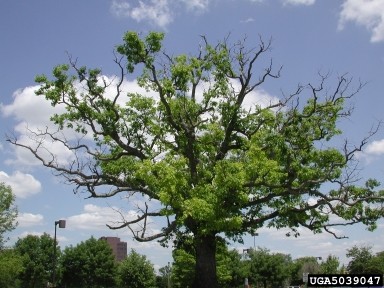Oak Decline
Oak decline is known as a decline complex: a complex that has many contributing stress agents, both biotic and abiotic, with no single agent playing a dominant role. Oak decline has been a major concern since the 1950’s when it was first noticed that mature and otherwise healthy oaks would begin to decline and slowly die over the course of several years. The disease complex affects oaks in both forested and urban settings. Drought, defoliation, and secondary stress agents are common contributors. Oak decline most heavily affects the red oak group, although white oaks can also be susceptible.

Early symptoms include late bud-break, small and/or chlorotic leaves, and scattered dead twigs. Leaf scorch, premature leaf-drop, early fall coloration, epicormic sprouts (suckers), and reduced diameter and shoot growth may also be observed. The most obvious symptoms occur during the later stages of the disease. Large branches or even entire sections of the crown will begin to die. Dieback most often proceeds from the top of the crown downward. This creates a “stag-head” effect: large antler-like branches (with no leaves) sticking up out of the remaining green crown below.
Oaks affected by decline are often host to a number of secondary insects and diseases, especially Armillaria root rot and the twolined chestnut borer. Signs of many wood borers, secondary fungi, and cankers are often visible.
Oak decline has been observed in many states in the U.S. for several decades. While the decline complex is associated with a variety of factors, certain years where abiotic factors may be more damaging to trees (droughts, severe storm damage, etc.) may lead to more secondary issues associated with the decline complex.
Because this decline complex is attributed to a variety of stressors, the best method to prevent this decline is to improve the health of susceptible oak trees. Proper tree care is critical. Provide trees adequate water (at least 1-2 inches per week below the entire drip line), fertilizer if necessary (avoid nitrogen rich fertilizers), and room to grow with little competition from neighboring trees or understory. Provide a thin layer of mulch (1-3 inches) below as much of the drip line as possible. Avoid planting susceptible species on dry sites. Planting the right species on the right site is the best way to lower the risk of oak decline.
In forested areas, proper silvicultural techniques can improve oak health. Thinning stands appropriately and encouraging oak regeneration on suitable sites may help improve oaks’ resilience to this complex of abiotic and biotic factors.
When oak decline has already begun to progress through a forested stand, salvage cutting may be an option if more than 30% of the canopy has experienced dieback. These trees may linger for years but cannot fully recover, so removal may help promote oak regeneration in stands already in decline.
What Can You Do?
As there are a variety of factors that can contribute to oak decline, managing oak trees and oak-dominated forests for healthy trees is the most proactive method to preserve oaks. Frequently monitor oaks and oak stands for symptoms of oak decline or signs of specific insect or pathogen damage (wood-boring beetle holes, cankers, fungal fruiting bodies growing from the tree, etc.). While there are no direct ways to treat trees for oak decline complex, monitoring and adjusting management of oaks to best protect trees can make these trees less susceptible to decline.
